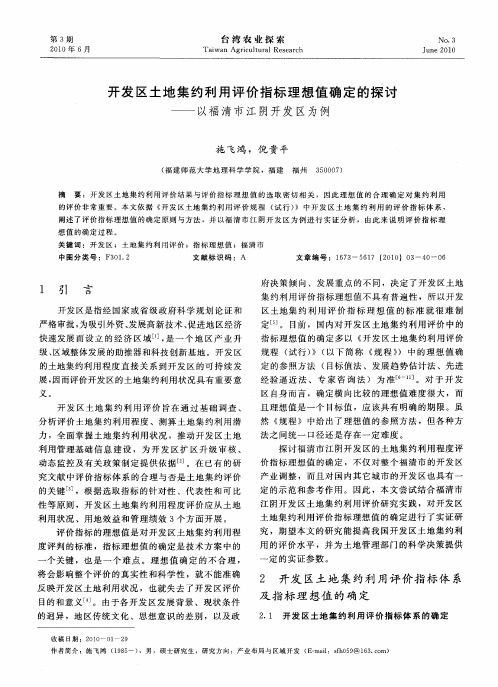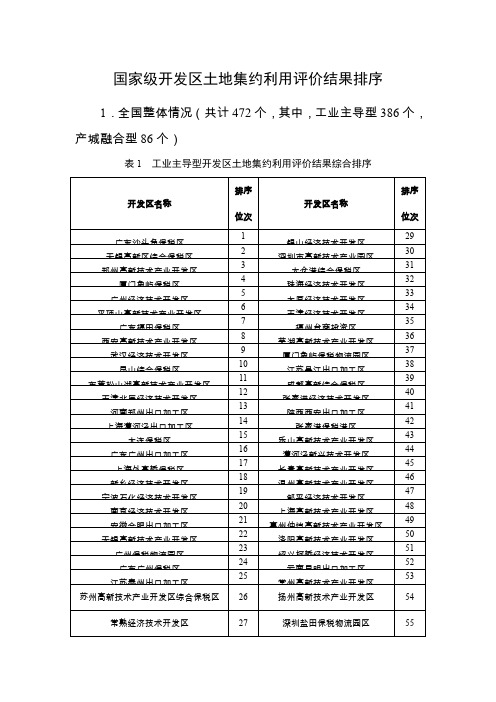开发区土地集约利用水平比较研究——以福清融侨经济技术开发区和福州元洪投资区为例
- 格式:pdf
- 大小:338.59 KB
- 文档页数:4

开发区土地集约利用评价与潜力测算研究--以青海高新技术产业开发区为例安蔚军;于书伦【期刊名称】《河南科学》【年(卷),期】2014(000)006【摘要】The development zones are key areas in urban development and land use aspect,have played a pivotal role to promote rapid economic development and critical evaluation of intensive land use in the development zone. We chose Three factors:land use situation,land use efficiency,management effectiveness,and totaling 13 evaluation indexes,to conduct intensive land use evaluation,and to estimate the potential for land use zone. Countermeasures were put forward for future work intensive land use on the basis of high-tech zones,for reference .%开发区作为城市发展和土地利用的重点区域,在促进经济高速发展中发挥了举足轻重的作用,对开发区土地集约利用的评价至关重要。
选择土地利用状况、用地效益、管理效益3项评价因素共计13项评价指标,进行开发区土地集约利用评价和潜力测算。
在此基础上对高新区今后土地集约利用工作提出相应的对策与建议。
【总页数】7页(P1108-1114)【作者】安蔚军;于书伦【作者单位】青海金地不动产评估咨询有限责任公司,西宁 810099;西安中策资讯科技有限责任公司,西安 710075【正文语种】中文【中图分类】F293.2【相关文献】1.土地集约利用评价与潜力测算研究——以河北省石家庄国家高新技术产业开发区为例 [J], 许振国;葛京凤;梁彦庆;王丽;王彦青;王以奎2.基于模糊综合评价模型的开发区土地集约利用评价研究——以重庆璧山高新技术产业开发区为例 [J], 左倩云3.开发区土地集约利用评价与潜力测算研究——以青海高新技术产业开发区为例[J], 张权;于书伦4.基于碳排放的开发区土地集约利用评价研究——以江苏省淮安高新技术产业开发区为例 [J], 宋喧;高玉昀;张敏5.城市开发区土地集约利用潜力测算实证研究——以鞍山高新技术产业开发区为例[J], 于清峰因版权原因,仅展示原文概要,查看原文内容请购买。

开发区土地集约利用评价模型及其应用研究的开题报告一、研究背景和选题意义随着城市化进程的加速和经济社会发展的需求,土地资源成为城市经济社会发展中的制约因素之一,而我国近年来发展迅速的开发区更需要充分利用土地资源来促进区域经济发展。
因此,开发区土地集约利用评价模型的研究有十分重要的意义。
二、研究目的与内容本研究旨在提出一种适用于开发区的土地集约利用评价模型,并探讨其应用。
具体来说,本研究将分析开发区土地利用现状,结合开发区土地管理和规划特点,考虑土地资源的空间分布、土地利用方式和土地利用效益等因素,构建开发区土地集约利用评价模型,并对模型进行实证分析和应用。
三、研究方法和步骤本研究将采用实地调研和数据分析相结合的方法,包括以下步骤:1. 综合分析开发区土地利用现状及存在的问题;2. 探索开发区土地利用的空间分布特征、土地利用方式及土地利用效益等要素,并建立土地集约利用评价指标体系;3. 建立开发区土地集约利用评价模型;4. 选取典型开发区进行实证分析;5. 探讨开发区土地集约利用评价模型的应用。
四、预期成果和创新点本研究将提出一种适用于开发区的土地集约利用评价模型,该模型能够客观评价开发区土地的集约利用情况,并为开发区土地管理提供科学指导,促进区域经济的健康持续发展。
研究创新点在于:考虑开发区土地管理规划特点,构建了适用于开发区的土地集约利用评价模型,并对模型进行实证分析和应用,为开发区土地管理提供了借鉴和思路。
五、论文的结构安排本论文的结构将分为以下几部分:1. 引言:阐述研究的背景、目的和意义,以及研究方法和步骤;2. 文献综述:回顾和分析相关领域的研究现状及存在的问题;3. 理论框架和方法:构建开发区土地集约利用评价模型和指标体系;4. 实证分析:选取典型开发区进行实证分析;5. 应用研究:探讨开发区土地集约利用评价模型的应用;6. 结论与展望:总结研究成果,指出不足之处,并对模型的应用前景进行展望。


第 41 卷 ,第 1 期 2024 年2 月15 日国土资源科技管理Vol. 41,No.1Feb. 15,2024 Scientific and Technological Management of Land and Resourcesdoi:10.3969/j.issn.1009-4210.2024.01.003不同主导功能开发区土地集约利用研究——以江苏省188个省级及以上开发区为例赵小风1,涂刘欣1,李炜玮2,贾文慧2(1.河海大学 公共管理学院,江苏 南京 211100;2.江苏省土地勘测规划院,江苏 南京 210024)摘 要:开发区是实体经济发展的重要载体。
研究不同主导功能开发区的土地集约利用对促进产业转型升级和区域高质量发展有重要意义。
文章以江苏省188个省级及以上开发区为例,构建了基于不同主导功能的具有可比性的开发区土地集约利用评价指标体系,运用AHP-CRITIC组合赋权法测算开发区土地利用集约度,并从开发区主导功能视角对比产城融合型和工业主导型开发区土地集约利用差异构建回归模型,探讨开发区主导功能对土地集约利用的影响。
研究表明:(1)江苏省开发区土地集约利用水平空间差异明显,不论是全部开发区还是不同主导功能开发区,土地利用集约度均呈现出苏南高、苏中次之、苏北最低的特点;(2)江苏省工业主导型开发区土地利用集约度高于产城融合型开发区;(3)开发区主导功能对土地集约利用水平具有显著影响,表现为产城融合型开发区对土地利用集约度有显著负效应。
关键词:开发区;主导功能;土地集约利用;空间差异;影响因素中图分类号:F301.24 文献标志码:A 文章编号:1009-4210-(2024)01-033-13 On Intensive Land Use of Development Zones with Different LeadingFunctions: A Case Study of 188 Development Zones at or above theProvincial Level in Jiangsu ProvinceZHAO Xiaofeng1,TU Liuxin1,LI Weiwei2,JIA Wenhui2(1. School of Public Administration,Hohai University,Nanjing 211100,Jiangsu,China;2. Jiangsu Institute of Land Surveying and Planning,Nanjing 210024,Jiangsu,China)Abstract: Development zones are important to the development of the real economy. Studying intensive land use of development zones with different leading functions is of great significance for industrial transformation and upgrading and high-quality regional development. Taking 188 development zones at or above the provincial level in Jiangsu Province as examples,this paper constructed a comparable evaluation 收稿日期:2023-10-30;改回日期:2023-11-23基金项目:国家自然科学基金(42371293,42001196);江苏省自然资源科技计划项目(2023010,2023045)作者简介:赵小风(1978—),男,博士,教授,从事土地政策、国土空间规划研究。

国家级开发区土地集约利用评价结果排序1.全国整体情况(共计472个,其中,工业主导型386个,产城融合型86个)表1 工业主导型开发区土地集约利用评价结果综合排序备注:1.部分近年设立的综合保税区由于在评价时点前未封关验收,仍按整合前的出口加工区进行评价和排序(11个),分别为:福州保税港区:按福建福清出口加工区和福州保税物流园区分别进行评价和排序;吴中综合保税区:按江苏吴中出口加工区进行评价和排序;吴江综合保税区:按江苏吴江出口加工区进行评价和排序;常州综合保税区:按江苏常州出口加工区进行评价和排序;常熟综合保税区:按江苏常熟出口加工区进行评价和排序;镇江综合保税区:按江苏镇江出口加工区进行评价和排序;武进综合保税区:按江苏武进出口加工区进行评价和排序;嘉兴综合保税区:按浙江嘉兴出口加工区进行评价和排序;泰州综合保税区:按江苏泰州出口加工区进行评价和排序;芜湖综合保税区:按安徽芜湖出口加工区进行评价和排序;深圳盐田综合保税区:按深圳盐田保税物流园区、盐田港保税区、广东沙头角保税区进行评价和排序。
表2 产城融合型开发区土地集约利用评价结果综合排序2.不同区域开发区情况(1)东部地区(共计232个,其中,工业主导型210个,产城融合型22个)表3 东部地区工业主导型开发区土地集约利用评价结果综合排序表4 东部地区产城融合型开发区土地集约利用评价结果综合排序(2)中部地区(共计95个,其中,工业主导型80个,产城融合型15个)表5 中部地区工业主导型开发区土地集约利用评价结果综合排序表6 中部地区产城融合型开发区土地集约利用评价结果综合排序(3)西部地区(共计105个,其中,工业主导型64个,产城融合型41个)表7 西部地区工业主导型开发区土地集约利用评价结果综合排序表8 西部地区产城融合型开发区土地集约利用评价结果综合排序(4)东北地区(共计40个,其中,工业主导型32个,产城融合型8个)表9 东北地区工业主导型开发区土地集约利用评价结果综合排序表10 东北地区产城融合型开发区土地集约利用评价结果综合排序备注:根据《中共中央、国务院关于促进中部地区崛起的若干意见》、《国务院发布关于西部大开发若干政策措施的实施意见》等文件关于区域的划分,东部地区包括:北京、天津、河北、上海、江苏、浙江、福建、山东、广东和海南等10个省(市);中部地区包括:山西、安徽、江西、河南、湖北和湖南等6个省;西部地区包括:内蒙古、广西、重庆、四川、贵州、云南、西藏、陕西、甘肃、青海、宁夏和新疆等12个省(区、市);东北地区包括:辽宁、吉林和黑龙江等3个省。

开发区土地集约利用分区评价
宫蕾
【期刊名称】《房地产评估》
【年(卷),期】2008(000)012
【摘要】研究目的:探究更加完善的开发区土地集约利用评价方法。
研究方法:实证与对比分析。
研究结果:(1)分区评价反映出中部起步区和典型企业所在区域集约水平较高,随着距中心区距离的增加集约水平逐渐降低的规律;(2)分区评价能够挖掘更大的土地集约利用潜力;(3)对商业和住宅功能区采用相应的评价指标体系能更准确地反映土地集约利用水平。
研究结论:分区评价能够更具体、更直观、更贴切地反映开发区土地集约利用情况。
【总页数】7页(P25-31)
【作者】宫蕾
【作者单位】大连理工大学06级工程管理专业研究生
【正文语种】中文
【中图分类】F293.2
【相关文献】
1.开发区土地集约利用分区评价——以大连经济技术开发区为例 [J], 宋永发;宫蕾
2.浅谈开发区土地集约利用评价方法初探——以哈尔滨平房汽车零部件产业园区土地集约利用评价为例 [J], 李克龙;范英莉;余素勋;王圣君
3.开发区土地集约利用评价方法与措施--以吉林靖宇经济开发区土地集约利用评价为例 [J], 刘国栋
4.基于土地集约利用的经济开发区建设用地供需仿真模拟
——以湖南邵阳经济开发区为例 [J], 谢谦;郭凌志;李辉;唐诗佳
5.开发区土地集约利用评价--以吉林公主岭经济开发区为例 [J], 李玉
因版权原因,仅展示原文概要,查看原文内容请购买。
试论开发区建设中的土地集约利用全文共四篇示例,供读者参考第一篇示例:试论开发区建设中的土地集约利用随着城市化进程的不断加速,土地资源日益紧缺的问题成为了摆在人们面前的一个现实难题。
为了更好地利用有限的土地资源,提高土地利用效率,开发区建设中的土地集约利用成为了一个值得关注和探讨的问题。
本文将从土地集约利用的概念、意义、现状和对策等方面进行深入探讨。
一、土地集约利用的概念土地集约利用是指在土地资源有限的情况下,通过提高土地利用效率,实现在同一单位土地面积上获得更高的经济效益、社会效益和生态效益的一种土地开发方式。
土地集约利用主要包括土地资源的有效开发、土地利用的多功能化和土地利用的高效化三个层面。
1. 促进城市可持续发展土地集约利用能够更好地满足城市发展对土地资源的需求,有效缓解城市土地紧张问题。
通过提高土地利用效率,可以减少对农村土地资源的过度占用,保护良好的农田资源,促进农业的可持续发展。
2. 提升城市发展效率3. 优化城市空间布局土地集约利用能够推动城市空间布局的优化和合理,提高城市的建设密度,降低城市用地的浪费,使城市更加紧凑和高效。
4. 保护生态环境土地集约利用能够更好地保护生态环境,减少土地开垦对生态系统的破坏,提高土地的生态效益,保护生态环境的可持续发展。
在当前的开发区建设中,土地集约利用还存在一些问题和不足。
主要表现在以下几个方面:1. 土地利用效率不高部分开发区存在土地利用效率不高的问题,土地资源得不到充分利用,造成土地资源的浪费和低效利用。
2. 开发区土地过度开发部分开发区存在土地过度开发的问题,土地资源受到过度占用,导致农田资源的大量消耗,对农业生产带来负面影响。
3. 土地使用单一化4. 缺乏科学管理部分开发区缺乏科学管理,对土地资源的保护和利用得不到有效的保障和监管,导致土地资源的浪费和滥用。
1. 加强规划引导加强对开发区建设的规划引导,科学进行土地利用规划,合理规划土地空间布局,推动土地资源的集约利用。
不同经济发展水平地区开发区土地集约利用的影响因素研究——以福建省为例范胜龙;张莉;曾在森;黄炎和;林翔程【摘要】By evaluating the provincial land intensive use of development zone in Fujian Province in 2016 and analyzing the main determinants regarding areas with different levels of economic development, the purpose of this paper is to improve the extent of land intensive use in development zone, to alleviate the human-land conflict and to protect the cultivated land resources. The multi-factor comprehensive evaluation method was applied to calculate the comprehensive scores of land use intensity in development zone. The barrier degree model and principal component analysis were used to determine the main factors influencing land intensive use in development zone. The research results show that: 1) the degree of land intensive use in development zone has correlation with the level of regional economic development on the whole. The relevance ranking is developed areas>sub-developed areas>underdeveloped areas.2)there is no obvious correlative rules among the degree of land intensive use in development zone and development zone age, distance from development zone to the county-level center. In the developed areas, the main socio-economic factors influencing land intensive use of development zone are the proportion of tertiary industry, the retail sales of social goods and the per capita disposable income of rural residents. In the sub-developed areas, the main factors influencing land intensive use ofdevelopment zone are urbanization level, the per capita disposable income of urban residents and rural residents. In the underdeveloped areas, the main factors influencing land intensive use of development zone are per capita disposable income of urban residents, proportion of secondary industry and urbanization level.%研究目的:对2016年福建省省级开发区土地集约利用进行评价,并分析影响不同经济发展水平地区开发区土地集约利用的主要因素,提高开发区土地集约利用水平,以缓解城市人地矛盾,保护耕地资源.研究方法:运用多因素综合评价法计算开发区土地利用集约度综合分值,通过障碍度模型和主成分分析法确定开发区土地集约利用的主要影响因素.研究结果:(1)各开发区土地集约利用水平总体上与区域经济发展水平相关.从开发区土地利用集约度看,发达地区>次发达地区>欠发达地区.(2)开发区区龄、开发区至县(市)中心距离与开发区土地集约利用水平之间不存在明显规律.研究结论:经济发达地区影响开发区土地集约利用水平的主要社会经济因素是第三产业比重、社会商品零售额、农村居民人均可支配收入;影响次发达地区开发区土地集约利用水平的主要因素是城镇化水平、城镇居民人均可支配收入、农村居民人均可支配收入;影响欠发达地区开发区土地集约利用水平的主要因素是城镇居民人均可支配收入、第二产业比重和城镇化水平.【期刊名称】《中国土地科学》【年(卷),期】2017(031)006【总页数】8页(P51-58)【关键词】土地利用;开发区;集约利用;影响因素;福建省【作者】范胜龙;张莉;曾在森;黄炎和;林翔程【作者单位】福建农林大学资源与环境学院,福建福州 350002;福建农林大学资源与环境学院,福建福州 350002;福建农林大学资源与环境学院,福建福州 350002;福建农林大学资源与环境学院,福建福州 350002;福建省国土资源勘测规划院,福建福州350002【正文语种】中文【中图分类】F301.2Abstract:By evaluating the provincial land intensive use of development zone in Fujian Province in 2016 and analyzing the main determinants regarding areas with different levels of economic development, the purpose of this paper is to improve the extent of land intensive use in development zone, to alleviate the human-land conflict and to protect thecultivated land resources. The multi-factor comprehensive evaluation method was applied to calculate the comprehensive scores of land use intensity in development zone. The barrier degree model and principal component analysis were used to determine the main factors influencing land intensive use in development zone. The research results show that: 1)the degree of land intensive use in development zone has correlation with the level of regional economic development on the whole. The relevance ranking is developed areas>sub-developed areas>underdeveloped areas. 2)there is no obvious correlative rules among the degree of land intensive use in development zone and development zone age, distance from development zone to the county-level center. In the developed areas, the main socio-economic factors influencing land intensive use ofdevelopment zone are the proportion of tertiary industry, the retail sales of social goods and the per capita disposable income of rural residents. In the sub-developed areas, the main factors influencing land intensive use of development zone are urbanization level, the per capita disposable income of urban residents and rural residents. In the underdeveloped areas, the main factors influencing land intensive use of development zone are per capita disposable income of urban residents, proportion of secondary industry and urbanization level.Key words:land use; development zone; intensive use; influence factors; Fujian Province作为工业发展和区域经济发展的重要领域,开发区在土地利用上呈现出一定程度的集聚效应,资金聚集程度、土地投入—产出强度远高于一般地区[1]。
福建省省级开发区土地集约利用程度区域分析摘要:作为地区经济发展的重要载体,开发区在带动区域产业发展和提高城市化水平方面都具有重要的意义,但也存在着不同程度的土地浪费和低效利用等问题。
本研究以福建省省级开发区为对象,从九个设区市省级开发区土地集约利用程度对比分析出发,运用比例推算法探讨各地开发区土地集约利用程度的差异。
研究结果表明,各设区市开发区土地集约水平存在明显差异,结合各地社会经济发展情况,提出相应的建议和对策。
关键词:开发区、集约利用、比例推算法Abstract:As the important carrier to develop the local economy,economic development zones have a lot of meaning for pushing industry development and civic level.But at the mean time,they have some problems including land wastage and low-level use.This research takes FuJian’s provincial normal economic development zones as examples,from nine city zones’variety in economic development zones’land intensive use,to analyze their difference.The result indicates that the nine cities’economic development zones have obvious difference in land intensive using level.Based on the nine cities’developing level,the research will try to give some useful advice.Key Words:economic development zone,land intensive use,ratio estimation method随着福建省社会经济的发展,开发区作为城市工业的集聚中心和经济增长的中坚力量,发挥着越来越重要的作用【1】。